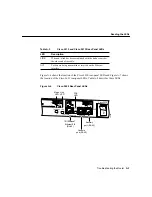
Cisco 2600 Series Hardware Installation Guide
Procedures for Recovering Boot and System Images
C-10
Using the tftpdnld Command
The tftpdnld command downloads a Cisco IOS software image from a remote server
accessible from an Ethernet or Token Ring network interface on a Cisco 2600 series router.
The tftpdnld command downloads the Cisco IOS software image into Flash memory using
TFTP.
The following software restrictions apply when using the tftpdnld command:
•
Ethernet platform—Only accepts and sends Ethernet V2.0 data packets.
•
Token Ring platform—Only accepts and sends Token Ring frames with IEEE802.3
SNAP frames. Does not support any frames with routing information fields (RIFs),
limiting all use of the tftpdnld command to a TFTP server on the local ring. If the TFTP
server resides off the local ring, you must establish a path to the server through a router
or transparent bridge from the local ring.
tftpdnld [-h] [-r]—Begins the TFTP copy procedure.
Options include the following:
•
h—Displays the tftpdnld command help screen.
•
r—Loads the Cisco IOS software image only to DRAM and launches the image without
writing the image into Flash memory.
The tftpdnld command requires that you specify certain variables when you issue the
command. The syntax for specifying the variables is:
VARIABLE_NAME=value
The variables that you must specify include the following:
•
IP_ADDRESS—IP address for the router you are using.
•
IP_SUBNET_MASK—Subnet mask for the router you are using.
•
DEFAULT_GATEWAY—Default gateway for the router you are using.
•
TFTP_SERVER—IP address of the server from which you want to download the image
file.
•
TFTP_FILE—Name of the file that you want to download.



































